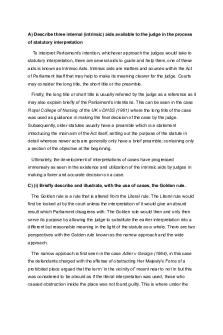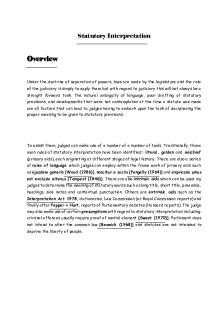Statutory Interpretation PDF

| Title | Statutory Interpretation |
|---|---|
| Author | Zainab Mir |
| Course | Legal system and method |
| Institution | University of London |
| Pages | 5 |
| File Size | 159.4 KB |
| File Type | |
| Total Downloads | 33 |
| Total Views | 812 |
Summary
Statutory InterpretationOverviewUnder the doctrine of separation of powers, laws are made by the legislature and the role of the judiciary is simply to apply them but with regard to judiciary this will not always be a straight forward task. The natural ambiguity of language, poor drafting of statuto...
Description
Statutory Interpretation
Overvie Overview w
Under the doctrine of separation of powers, laws are made by the legislature and the role of the judiciary is simply to apply them but with regard to judiciary this will not always be a straight forward task. The natural ambiguity of language, poor drafting of statutory provisions, and developments that were not contemplated at the time a statute was made are all factors that can lead to judges having to embark upon the task of deciphering the proper meaning to be given to statutory provisions.
To assist them, judges can make use of a number of a number of tools. Traditionally, three main rules of statutory interpretation have been identified: literal, golden and mischief (primary aids), each originating at different stages of legal history. There are also a series of rules of language which judges can employ within the frame work of primary aids such as ejusdem generis [Wood (1986)], noscitur a sociis [Pengelly (1964)] and expressio unius est exclusio alterus [Tempest (1846)]. There are also intrinsic aids which can be used my judges to determine the meaning of statutory words such as long title, short title, preamble, headings, side notes and contextual punctuation. Others are extrinsic aids such as the Interpretation Act 1978, dictionaries, Law Commission (or Royal Commission reports) and finally after Pepper v Hart, reports of Parliamentary debates (Hansard reports). The judge may also make use of certain presumptions with regard to statutory interpretation including: criminal offences usually require proof of mental element [Sweet (1970)] ; Parliament does not intend to alter the common law [Beswick (1968)] and statutes are not intended to deprive the liberty of people.
The literal rule requires that words are given their ordinary, grammatical meaning, even if this produces an absurd outcome. Many of the texts trace the use of the literal rule of the statement of Tindal CJ in the Sussex Peerage case of 1844. An example of its application is found in Fisher (1960), where a shopkeeper charged under the Restriction of Offensive Weapons Act 1959 with offering for sale a prohibited knife was acquitted, as under contract law the display of an item did not constitute an offer but an invitation to treat, even though the Act had been created to restrict the sale of such items. Similarly, the cases of Whiteley (1868), Berriman (1946) and Cheeseman (1990) are a great example where the literal rule was applied. The advantages of the literal rule include: it safeguards sovereignty of Parliament, separation of powers and rule of law; it prevents judicial activism and makes the law more certain and easier to understand. The cons are as follows: not every Act is perfectly drafted (there was confusion over the word type and breed in the Dangerous Dogs Act 1991 ); not every Act covers every situation (when the Theft Act 1968 was enacted, it could not be foreseen that information over the internet could be stolen); it can lead to an absurd, unfair or unjust decisions.
The golden rule is an extension of the literal rule and was set out by Lord Wensleydale in Grey (1857). Essentially, the literal meaning of a provision should be applied unless it produces absurdity or is repugnant. The golden rule is divided into narrow and wider meanings. The former occurs when two alternative meanings can be applied to a provision, one of which will result in absurdity or repugnance. The court is to apply the meaning that will not have this effect. An example Allen (1872), which was concerned with bigamy and the meaning of words ‘shall marry’ was under consideration, the court in this case read the words in the section ‘shall marry’ as meaning ‘going through the ceremony’. Alder (1964) is another example of the narrow application. The wider meaning applies when there is only one meaning to the provision that will result in absurdity or repugnance. The court may then substitute an alternative meaning. This occurred in Re Sigsworth (1935) where the defendant had murdered his mother, repugnant that ‘issue’ should inherit estate. Principle applied here was that of ‘public policy’, which prevents a murderer, reaping the fruits of his crime. The merits include: it provides an escape route from absurd literal meanings; it allows the judges to choose the most sensible of words; and it can avoid a repugnant, unjust and immoral situation. The disadvantages include: it is limited in its use; it is erratic; and as the Law Commission noted in 1969 that the rule provides no clear meaning of an absurd result.
The mischief rule is the departure from the other two rules in that it concentrate not solely on the words of the statute but on the purpose for which parliament enacted the statute. It originated from the Heydon’s Case (1584) with four questions for the court to consider: what was the common law before the Act; what was the mischief that common law had not fixed; how did Parliament resolve it; and why did Parliament want to resolve it. The mischief rule was applied in Smith (1960) where defendants were charged under the Sexual offences Act 1959 with soliciting in a public place. The prostitutes were soliciting from windows, technically not a public place. The Mischief Rule was applied to interpret that the prostitutes were doing what the statute was trying to abolish so they were convicted. The case of Corkery (1951) is another example of the application of mischief rule. The pros include: promotes the purpose of the law; fills any gaps in the law, usually promotes a ‘just’ result; judges try to interpret the law as Parliament meant it to work; and the Law Commission prefers this rule. The cons are as follows: there is a risk of judicial law making; it can lead to uncertainty in law; and it is not as wide as the purposive approach as it is limited to looking at the gap in the old law.
As per Lord Denning’s judgement in Nothman [1978] , the purposive approach is one that will “promote the general legislative purpose underlying the provisions “. It is used by the majority of European countries when interpreting their own legislation and also by the European Court of Justice in interpreting European Union law and is becoming increasingly influential. This approach to statutory interpretation seeks to look for the purpose of the legislation before interpreting the words. The UK courts have used it when interpreting domestic legislation to give an interpretation in line with EU law [Pickstone (1989)]. The purposive approach has been highly influential and judges have applied it when interpreting domestic legislation which has no connection with EU law: Pepper [1992] and Jones (1997). The merits include: It is a flexible approach which allows judges to develop the law in line with Parliament's intention; it allows judges to cope with situations unforeseen by Parliament; and it allows the law to develop to cover advances in medical science. The drawbacks include: Judges become law makers infringing the Separation of Powers and there is scope for judicial bias in deciding what Parliament intended.
JUDICIAL A APPROACH PPROACH Until relatively recently there was little dispute that literal rule was the dominant rule. It was developed in the early 19th century and the first sustained support for it appears to have come from Lord Tenterden in cases decided in 1820’s. In the case of Stock (1978), Lord Edmund Davis preferred the literal approach by stating that if the words of the statute are clear, they must be applied even though the result is absurd. Judicial favor to the literal approach can also be illustrated by a number of cases including: Magor and St Mellons (1951), Sirs (1980) and Black Clawson case. There has also been a considerable amount of support for mischief rule as Lord Scarman in Woods (1979) construed ‘trade dispute’ by using the mischief rule. In Jones (1990) Donaldson MR also favored the mischief rule. Furthermore, HOL moved towards the mischief rule in the interpretation of international convention and treaties as can be illustrated by the cases of Fothergill (1980) and Pickstone (1989). During his judicial career, Lord Denning was in forefront of moves to establish a more purposive approach. In Carocraft (1969) he said “… the literal meaning of the words is never allowed to prevail where it would produce manifest absurdity or consequences which can never have been intended by the legislature”. Similar views were given by Lord Denning in Engineering Industry Training Board (1969). Section 2(4) of the European Communities Act 1972 provides that English law should be interpreted and given effect that European law is supreme. If an English statute cannot be interpreted in a way that is consistent with EU law, the inconsistent law should not be applied [Factortame (no 2)(1991)].
To conclude, it may be said that the court may invoke whichever of the rules produces the result that satisfies its sense of justice in the case before it. There is diversity of judicial approach which is well illustrated by the speeches of HOLs in Ballrooms Co (1970) (where judges disagreed over these rules of interpretation). Moreover, it must be noted that none of these rules are binding and it is not necessary for a judge to express which rule has been adopted.
HUMAN RIGHTS
Moreover, the Human Rights Act 1998 has brought about fundamental changes in statutory interpretation. Section 3 of the Act provides that ‘so far as it is possible to do so, primary legislation and subordinate legislation must be read and given effect in a way which is compatible with the convention rights. The extent of the interpretative obligation imposed by S3 was considered by the HOL in R V. A (2002). Lord Steyn was of the opinion that to carry out ‘the will of the parliament as reflected in .3, it might sometimes be necessary ‘to adopt an interpretation which linguistically may appear strained’. S3 provided the basis for the reinterpretation of statutory provision to make it compatible with convention rights in Ghaiden (2004). The Rent Act 1977 provided that on the death of a protected tenant his or her surviving spouse because a statutory tenant by succession. The HOL in Fitzpatrick (2001) had ruled that this provision did not include same-sex couples. However, in Ghaiden, the HOL used S3 as a remedial section to reinterpret the provision and treated same-sex couple’s equal to husband and wife.
Whereas, S4 applies in the case where the court is unable to read and give effect to domestic legislation to make it compatible with convention rights; a declaration of incompatibility may be issued. The first declaration of incompatibility was given in R V. Secretary of State for Environment . Whereas, in Anderson (2002); the HOL ruled that the power of Home secretary to determine the minimum term of life sentence in England and Wales was incompatible with Article 6 (after ECHR’s decision in Stafford V. UK). In Bellinger (2003); the HOL ruled that the laws that prevented homosexual from entering into legal marriage were incompatible with Article 12 and therefore the Parliament enacted the Gender Recognition Act 2004 , allowing homosexuals to have the change of gender recognized (after ECHR’s decision in Goodwin)....
Similar Free PDFs

Statutory Interpretation
- 6 Pages

Statutory Interpretation
- 6 Pages

Statutory Interpretation
- 3 Pages

Statutory Interpretation
- 5 Pages

Statutory Interpretation
- 11 Pages

Statutory Interpretation
- 6 Pages

Statutory interpretation notes
- 2 Pages

Statutory Interpretation 70102
- 5 Pages

Statutory Interpretation in Malaysia
- 12 Pages

Statutory Interpretation Notes
- 9 Pages

Statutory Interpretation Notes
- 4 Pages
Popular Institutions
- Tinajero National High School - Annex
- Politeknik Caltex Riau
- Yokohama City University
- SGT University
- University of Al-Qadisiyah
- Divine Word College of Vigan
- Techniek College Rotterdam
- Universidade de Santiago
- Universiti Teknologi MARA Cawangan Johor Kampus Pasir Gudang
- Poltekkes Kemenkes Yogyakarta
- Baguio City National High School
- Colegio san marcos
- preparatoria uno
- Centro de Bachillerato Tecnológico Industrial y de Servicios No. 107
- Dalian Maritime University
- Quang Trung Secondary School
- Colegio Tecnológico en Informática
- Corporación Regional de Educación Superior
- Grupo CEDVA
- Dar Al Uloom University
- Centro de Estudios Preuniversitarios de la Universidad Nacional de Ingeniería
- 上智大学
- Aakash International School, Nuna Majara
- San Felipe Neri Catholic School
- Kang Chiao International School - New Taipei City
- Misamis Occidental National High School
- Institución Educativa Escuela Normal Juan Ladrilleros
- Kolehiyo ng Pantukan
- Batanes State College
- Instituto Continental
- Sekolah Menengah Kejuruan Kesehatan Kaltara (Tarakan)
- Colegio de La Inmaculada Concepcion - Cebu




